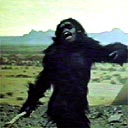|
iconography: Use of a well-known symbol or action.
IMAX: A big screen film format about ten times larger than the traditional format and about three
times larger than the standard widescreen format.
independent films: Small, low budget films not associated with or produced by a major Hollywood
studio; oftentimes not produced with commercial success in mind.
insert shot: A shot that occurs in the middle of a larger scene, usually a close-up. Its intent
is to draw the audiences attention or provide specific information.
inside joke: An obscure, show business related joke that is understood only by those who know
the reference.
interior: An indoor scene.
interlude: An intervening film scene or sequence that isn't specifically tied to the plot.
intrusion: Is an event that interrupts the stasis of a film.
jukebox musical: A musical that uses pre-existing popular songs for its score. Examples: "Singin'
in the Rain" (1952) & "Moulin Rouge" (2001).

jump cut: An abrupt, disorienting transistional device in the middle of a continous shot in which
the action is noticeably advanced in time and cut between two similar scenes. Example: In Stanley Kubrick's 1968 film "2001:
A Space Odyssey" when the bone tossed into the air by the ape turns into a spaceship (pictured).
juxtaposition: The continous positioning of either two images, characters, objects, or two scenes
in sequence to compare and contrast them or show a realtionship between the two. Example: The baptism scene at the end of
"The Godfather."
key light: The main or primary light on a subject, often angled and off-center that selectively
illuminates prominent features of the image to produce depth, shadows, etc.
kinescope: A motion picture camera that is used to photograph video off of a television monitor.
|